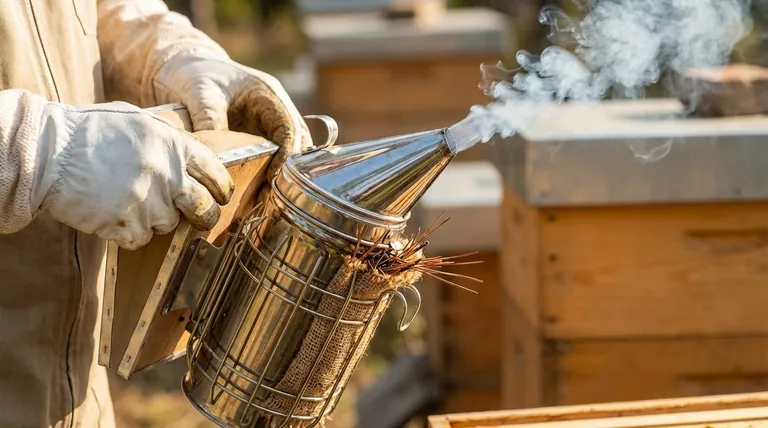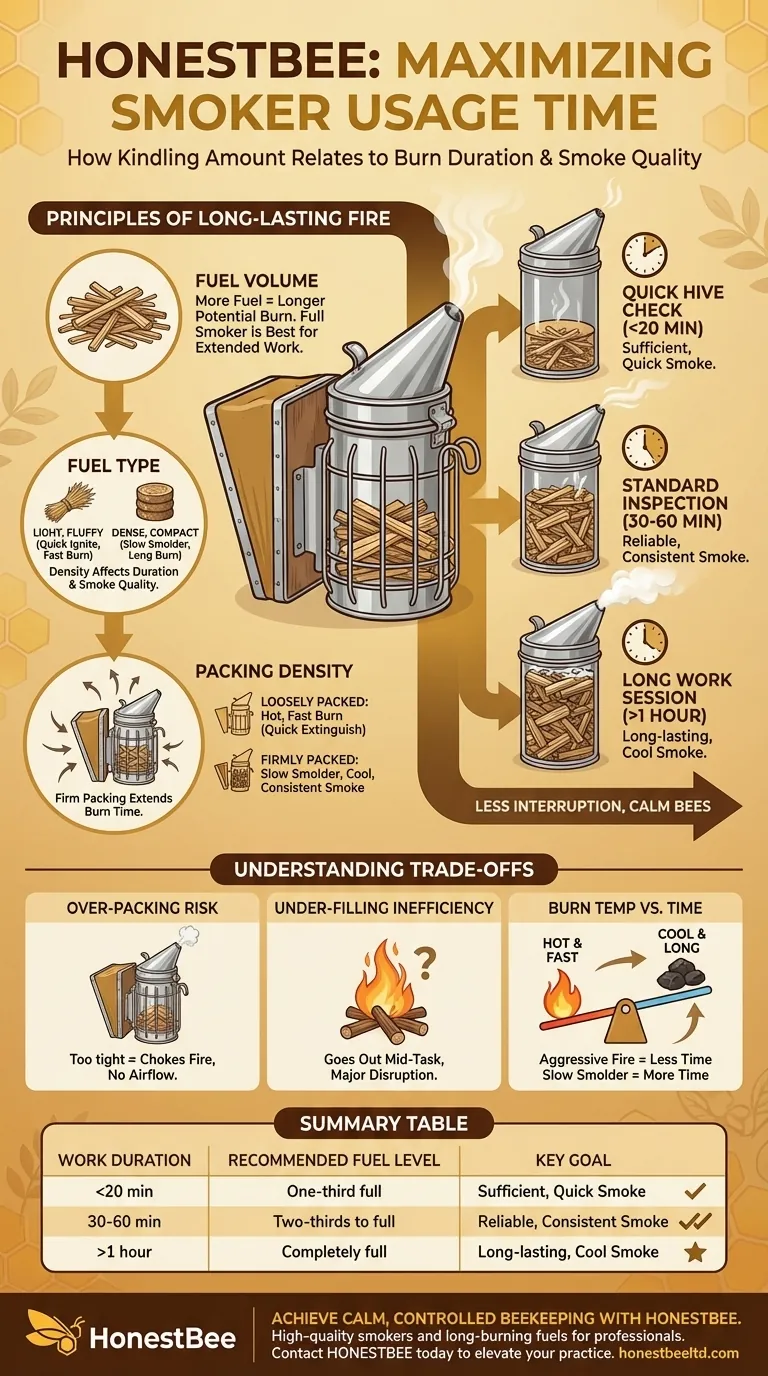In short, the more kindling you use, the longer your smoker will stay lit. For any work lasting longer than an hour, the standard practice is to fill the smoker canister completely. This creates a larger fuel reserve that burns down slowly, minimizing the need to interrupt your work to add more fuel and relight the fire.
The real goal isn't just a long-lasting fire, but a consistently manageable one. Mastering your smoker is less about the exact quantity of fuel and more about the quality of the fuel and how you pack it to produce cool, consistent smoke.

The Principles of a Long-Lasting Smoker Fire
A smoker is a simple tool, but its performance depends on the physics of combustion: fuel, oxygen, and heat. Controlling these variables is the key to a reliable smoker.
How Fuel Volume Dictates Burn Time
The most direct factor is fuel volume. A smoker that is only half-full has half the potential burn time of a completely full one, all other things being equal. A larger mass of fuel simply takes longer to be consumed.
For extended sessions involving multiple hives, starting with a full smoker is a non-negotiable best practice. It prevents the fire from dying at a critical moment.
Why Fuel Type is Just as Important
Not all fuels are created equal. The density and composition of your kindling dramatically affect both the duration and quality of the smoke.
- Light, fluffy fuels (dried grass, pine needles) ignite easily and produce thick smoke quickly, but they also burn out very fast.
- Dense, compact fuels (wood pellets, burlap, compressed cotton) take more effort to light but smolder for a very long time, providing a consistent and cooler smoke.
A common professional technique is to start the fire with a small amount of light fuel and then add denser fuel on top for the long-duration burn.
The Critical Role of Packing Density
How you pack the fuel is crucial. A loosely packed smoker allows for more airflow, leading to a hotter, faster-burning fire that will extinguish itself quickly.
Conversely, a firmly packed smoker restricts airflow. This forces the fuel to smolder slowly from the top down, extending the burn time significantly and producing the desirable cool, white smoke that calms bees without alarming them.
Understanding the Trade-offs
Achieving the perfect burn requires balancing competing factors. Being aware of these trade-offs will help you troubleshoot and adapt.
The Risk of Over-Packing
While firm packing is good, over-compacting the fuel can choke the fire entirely. If you pack the kindling so tightly that no air can circulate from the bellows, the fire will suffocate and go out, regardless of how much fuel you used.
The Inefficiency of Under-Filling
For any task beyond a quick five-minute check, an under-filled smoker is a liability. It will likely go out mid-inspection, forcing you to stop, remove your gloves, and relight it—a major disruption to your workflow and a potential agitation to the bees.
Burn Temperature vs. Burn Time
There is a direct trade-off between the heat of the fire and its longevity. An aggressive fire with lots of oxygen will burn very hot but consume its fuel rapidly. Your goal is a slow, smoldering coal bed that burns for a long time with minimal heat.
Matching Your Fuel Strategy to Your Task
Use your intended work time to guide your smoker preparation.
- If your primary focus is a quick hive check (under 20 minutes): Filling the smoker about one-third full with a moderately packed, mid-weight fuel is sufficient.
- If your primary focus is a standard, single-hive inspection (30-60 minutes): Fill the smoker two-thirds to completely full with a firmly packed, denser fuel.
- If your primary focus is a long work session in the apiary (over 1 hour): Completely fill the smoker with your longest-burning fuel, packed firmly, and consider bringing extra fuel to top it off as needed.
Mastering your smoker is a foundational skill that transforms beekeeping from a reactive struggle to a calm, controlled practice.
Summary Table:
| Work Duration | Recommended Fuel Level | Key Goal |
|---|---|---|
| Quick Check (<20 min) | One-third full | Sufficient, quick smoke |
| Standard Inspection (30-60 min) | Two-thirds to full | Reliable, consistent smoke |
| Long Session (>1 hour) | Completely full | Long-lasting, cool smoke |
Achieve Calm, Controlled Beekeeping with Reliable Equipment
Mastering your smoker is essential for productive hive management. HONESTBEE supplies commercial apiaries and beekeeping equipment distributors with high-quality, durable smokers and long-burning fuels designed for professional use. Our wholesale-focused operations ensure you get the reliable equipment you need to maintain consistent smoke and minimize disruptions during long work sessions.
Contact HONESTBEE today to discuss your smoker and fuel requirements and elevate your beekeeping practice.
Visual Guide

Related Products
- Stainless Steel Honey Bee Smoker Hive and Honeycomb Smoker for Beekeeping
- Premium Traditional Copper Bee Smoker with Bellows
- Economy Galvanized Beekeeping Honey Bee Smoker for Wholesale
- Professional Bee Smoker with Elongated Spout and Durable Bellows for Beekeeping
- Miniature Stainless Steel Bee Smoker for Beekeeping
People Also Ask
- What is the proper technique for lighting a bee smoker? Master the Layered Fire Method for Calm Hives
- What is the purpose of a bee smoker and how should it be used? A Guide to Calm, Safe Hive Inspections
- What is a bee smoker and what is its primary purpose? Master Safe Hive Inspections
- What is a bee smoker and how does it work? Master the Tool for Calm, Safe Hive Inspections
- How long does it take to clean a bee smoker? From 15-Minute Quick Fix to 10-Hour Deep Clean



















